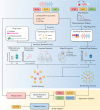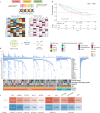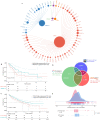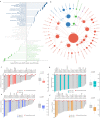Exploring synthetic lethal network for the precision treatment of clear cell renal cell carcinoma
- PMID: 35918352
- PMCID: PMC9345903
- DOI: 10.1038/s41598-022-16657-7
Exploring synthetic lethal network for the precision treatment of clear cell renal cell carcinoma
Abstract
The emerging targeted therapies have revolutionized the treatment of advanced clear cell renal cell carcinoma (ccRCC) over the past 15 years. Nevertheless, lack of personalized treatment limits the development of effective clinical guidelines and improvement of patient prognosis. In this study, large-scale genomic profiles from ccRCC cohorts were explored for integrative analysis. A credible method was developed to identify synthetic lethality (SL) pairs and a list of 72 candidate pairs was determined, which might be utilized to selectively eliminate tumors with genetic aberrations using SL partners of specific mutations. Further analysis identified BRD4 and PRKDC as novel medical targets for patients with BAP1 mutations. After mapping these target genes to the comprehensive drug datasets, two agents (BI-2536 and PI-103) were found to have considerable therapeutic potentials in the BAP1 mutant tumors. Overall, our findings provided insight into the overview of ccRCC mutation patterns and offered novel opportunities for improving individualized cancer treatment.
© 2022. The Author(s).
Conflict of interest statement
The authors declare no competing interests.
Figures





Similar articles
-
PBRM1 and BAP1 as novel targets for renal cell carcinoma.Cancer J. 2013 Jul-Aug;19(4):324-32. doi: 10.1097/PPO.0b013e3182a102d1. Cancer J. 2013. PMID: 23867514 Free PMC article.
-
BAP1, PBRM1 and SETD2 in clear-cell renal cell carcinoma: molecular diagnostics and possible targets for personalized therapies.Expert Rev Mol Diagn. 2015;15(9):1201-10. doi: 10.1586/14737159.2015.1068122. Epub 2015 Jul 11. Expert Rev Mol Diagn. 2015. PMID: 26166446 Review.
-
The expanding role of BAP1 in clear cell renal cell carcinoma.Hum Pathol. 2023 Mar;133:22-31. doi: 10.1016/j.humpath.2022.07.022. Epub 2022 Aug 4. Hum Pathol. 2023. PMID: 35932824 Free PMC article. Review.
-
Effects on survival of BAP1 and PBRM1 mutations in sporadic clear-cell renal-cell carcinoma: a retrospective analysis with independent validation.Lancet Oncol. 2013 Feb;14(2):159-167. doi: 10.1016/S1470-2045(12)70584-3. Epub 2013 Jan 16. Lancet Oncol. 2013. PMID: 23333114 Free PMC article.
-
Genomically annotated risk model for advanced renal-cell carcinoma: a retrospective cohort study.Lancet Oncol. 2018 Dec;19(12):1688-1698. doi: 10.1016/S1470-2045(18)30648-X. Epub 2018 Nov 8. Lancet Oncol. 2018. PMID: 30416077 Free PMC article.
Cited by
-
The BAP1 nuclear deubiquitinase is involved in the nonhomologous end-joining pathway of double-strand DNA repair through interaction with DNA-PK.Oncogene. 2024 Apr;43(15):1087-1097. doi: 10.1038/s41388-024-02966-w. Epub 2024 Feb 21. Oncogene. 2024. PMID: 38383726 Free PMC article.
-
Von Hippel-Lindau protein signalling in clear cell renal cell carcinoma.Nat Rev Urol. 2024 Nov;21(11):662-675. doi: 10.1038/s41585-024-00876-w. Epub 2024 May 2. Nat Rev Urol. 2024. PMID: 38698165 Review.
References
Publication types
MeSH terms
Substances
LinkOut - more resources
Full Text Sources
Medical
Research Materials
Miscellaneous

